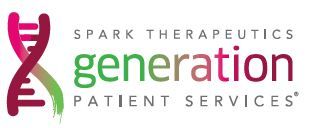Patient Advocacy
For questions about all of Spark Therapeutics’ programs:
Email: patients@sparktx.com
Call: 1-855-SPARKTX /
+1 215-220-9300 in the United States.
At Spark® Therapeutics, our Patient Advocacy team serves as a bridge between Spark and members of the patient and caregiver community.
Through communication about our programs and with input from the community, Spark aspires to bring forward meaningful solutions. Spark Patient Advocacy gathers patient insights, seeks to understand unmet needs, and strategically partners with Spark colleagues to ensure patient communities are the guiding force for Spark throughout the program and product life cycle.
For questions about all of Spark Therapeutics’ programs:
Email: patients@sparktx.com
Call: 1-855-SPARKTX /
+1 215-220-9300 in the United States.

Providing a caring support team, from confirmed biallelic RPE65-mediated IRD diagnosis through post-surgery follow-up.
For more information, visit: MySparkGeneration.com
For questions, contact us at:
1-833-SPARK-PS (833-772-7577)
As our scientific programs progress, we are grateful to work alongside advocacy groups, raising awareness of and supporting people affected by diseases. Learn more about our disease areas of focus, and hear from members of our scientific team about what motivates them every day to propel Spark Therapeutics’ gene therapy research programs forward.
Spark® Therapeutics is discovering and developing investigational gene therapies for debilitating inherited diseases, including inherited retinal diseases (IRDs), liver-directed diseases such as hemophilia, and neurodegenerative diseases. To see our current pipeline of investigational therapies, click here.